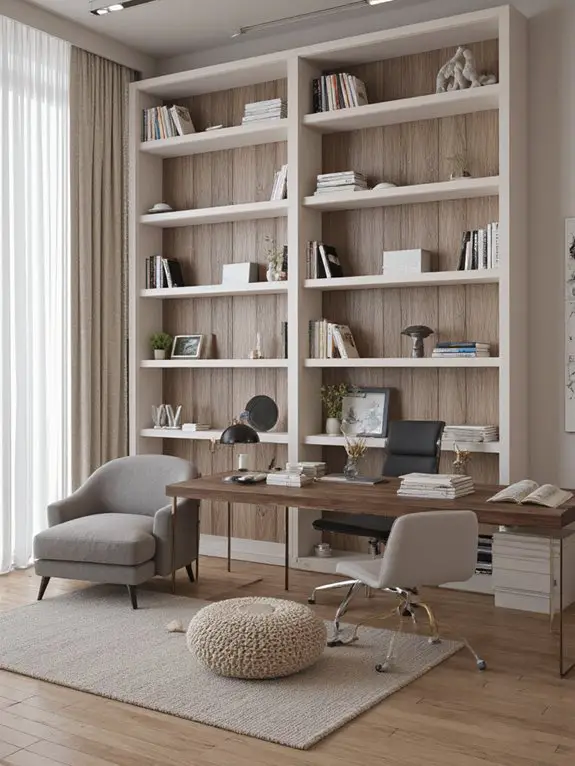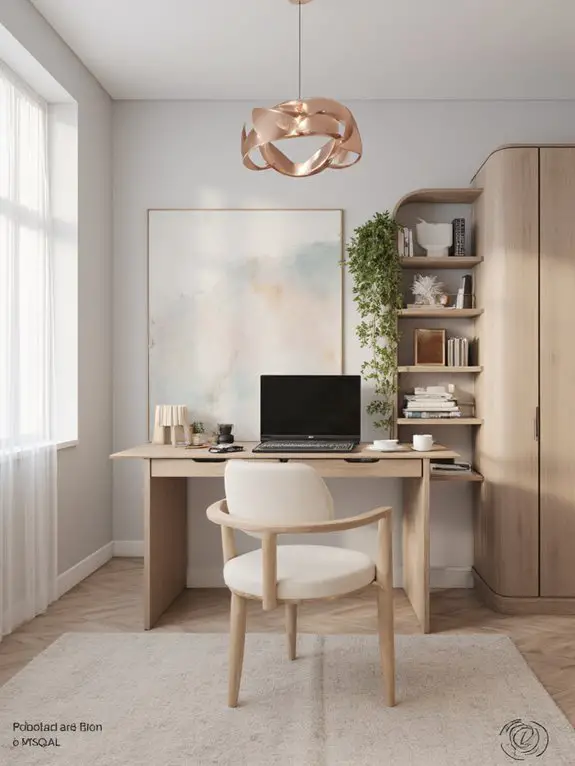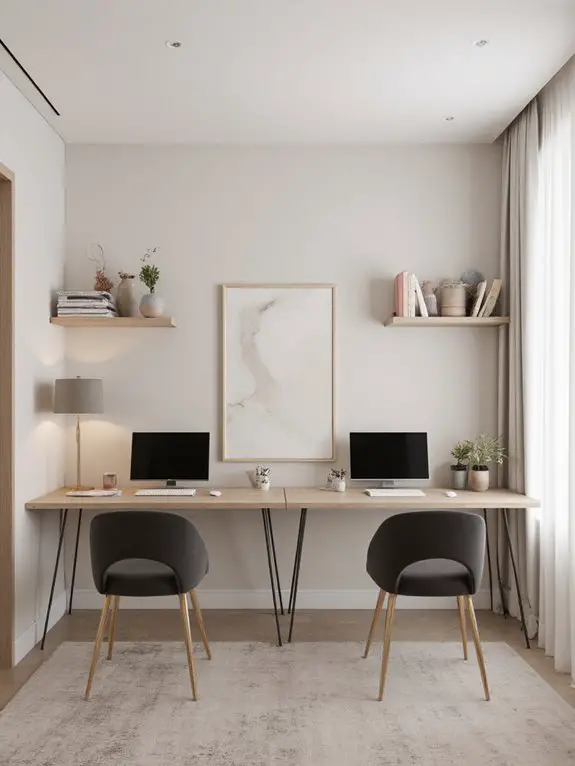When designing a home office, I start by choosing a dedicated space with minimal distractions and prioritize ergonomics with an adjustable chair and desk to reduce strain. I go for a minimalist design with neutral colors and add natural light to create an inviting atmosphere. Vertical storage and hidden solutions keep clutter at bay, while adjustable furniture and inspirational quotes boost productivity. Staying organized with tidy cables guarantees a seamless workflow, and there’s always more to explore for refining your setup.
Choose a Dedicated Space
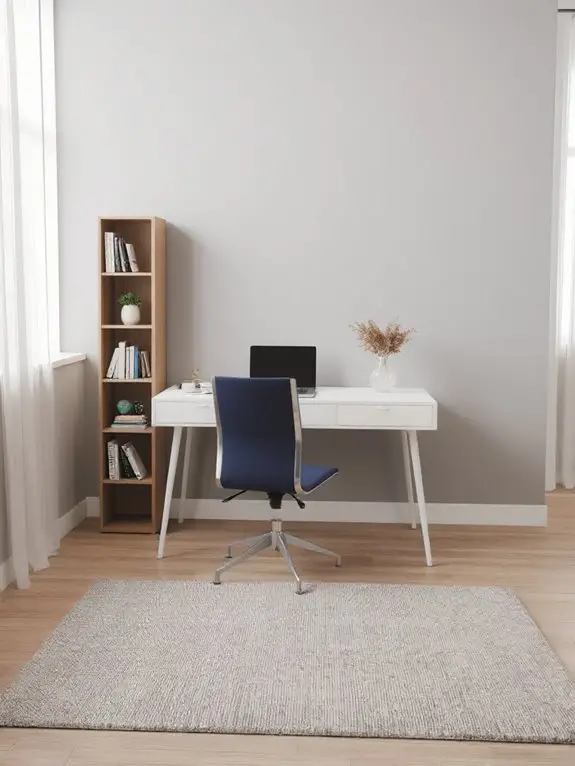
Choosing a dedicated space for your home office is essential for productivity and focus. I’ve learned that picking a spot with minimal distractions makes all the difference. I prefer a quiet corner or a spare room where I can close the door and mentally shift into work mode. Natural light’s a huge plus—it keeps me energized and reduces eye strain.
I also make sure the area feels separate from my living space, so I’m not tempted to blur the lines between work and relaxation. Having a designated spot not only boosts efficiency but also helps me maintain a healthier work-life balance.
Prioritize Ergonomics

When setting up a home office, I’ve found that prioritizing ergonomics can markedly impact comfort and productivity over long hours. For me, the chair is the foundation—I always choose one with lumbar support and adjustable height to maintain proper posture.
My desk height allows my arms to rest at a 90-degree angle while typing, preventing strain. I’ve also positioned my monitor at eye level, about an arm’s length away, to reduce neck strain.
Wrist rests and an ergonomic keyboard have been game-changers for my wrists. Good lighting minimizes eye strain, and I take short breaks to stretch and refocus.
Opt for a Minimalist Design
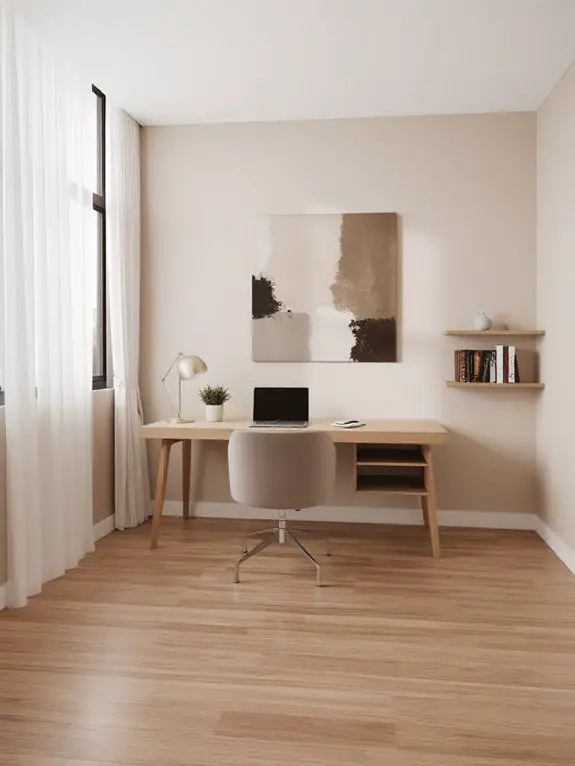
While a cluttered workspace can overwhelm the mind, I’ve discovered that a minimalist design creates a sense of calm and focus in my home office. I started by removing unnecessary items, keeping only what I use daily.
A clean desk with a few essential tools and a single piece of decor helps me stay organized and productive. I chose furniture with simple lines and neutral colors to maintain a cohesive look.
Storage solutions like drawers or shelves keep clutter hidden but accessible. By eliminating distractions, I’ve found my mind clearer and my work more efficient. Minimalism truly transforms my workspace.
Incorporate Natural Light
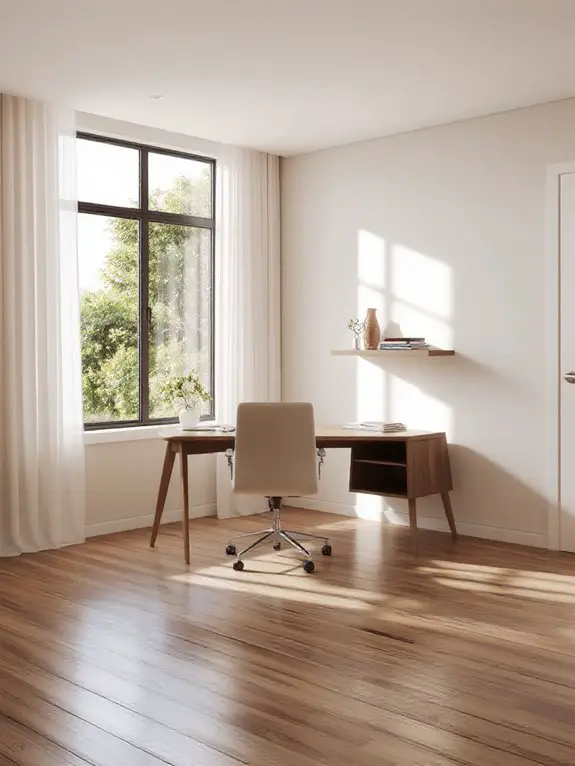
Natural light not only brightens my workspace but also boosts my mood and productivity, so I prioritize positioning my desk near a window. I make sure the window is unobstructed by heavy curtains, opting for light-filtering blinds or sheer fabrics to diffuse glare while maintaining brightness.
I also angle my monitor to avoid direct sunlight, which reduces eye strain. If my workspace lacks windows, I use full-spectrum light bulbs to mimic natural daylight. Additionally, I keep the area around my desk clutter-free to maximize light reflection.
Incorporating natural light creates a welcoming, energizing environment that enhances focus and creativity throughout my workday.
Utilize Vertical Storage

To make the most of limited space in my home office, I’ve found that vertical storage solutions are essential. I’ve installed floating shelves above my desk to keep books, supplies, and decor within reach but off the surface.
A tall bookcase or storage unit maximizes unused wall space, offering room for binders, files, and equipment. I use wall-mounted organizers for pens, notebooks, and small accessories, freeing up desk drawers for bulkier items.
Pegboards are another versatile option for hanging tools or baskets. By thinking upward, I’ve streamlined my workspace, keeping it functional and clutter-free without sacrificing style.
Add Greenery for Freshness
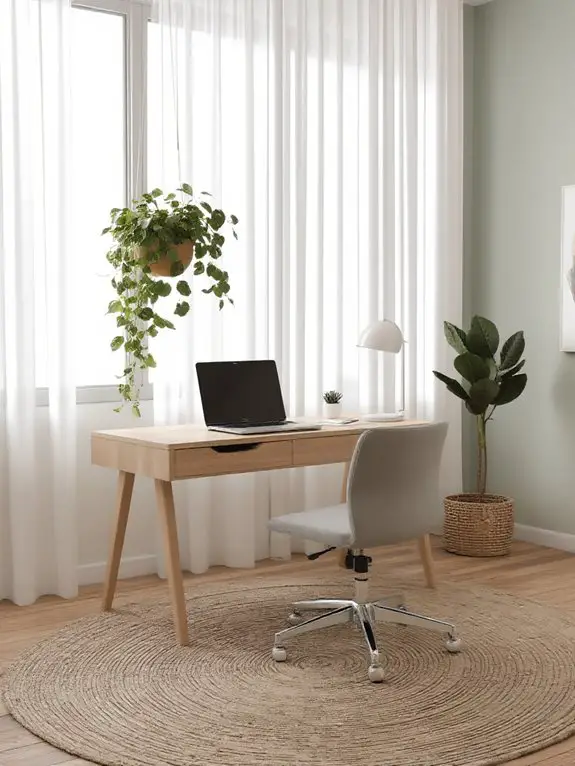
Incorporating greenery into my home office has transformed the space, making it feel more vibrant and alive. I’ve added a mix of low-maintenance plants like snake plants and pothos, which thrive in indirect light and require minimal care.
Placing them on shelves, desks, and hanging planters creates a natural, invigorating ambiance. Not only do they improve air quality, but they also reduce stress and boost productivity.
I’ve found that grouping plants in odd numbers adds visual interest, while terracotta pots complement the greenery perfectly. Even a single statement plant, like a fiddle-leaf fig, can make a significant impact.
Greenery truly breathes life into my workspace.
Use Multi-Functional Furniture
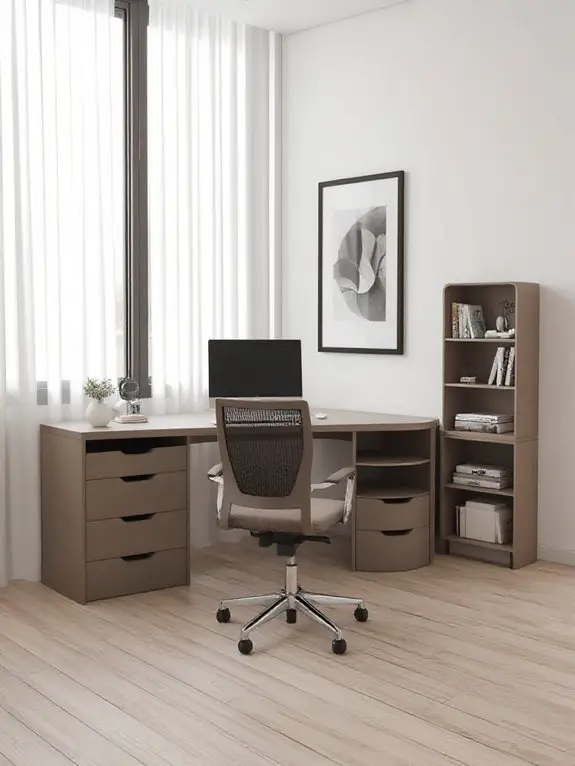
Multi-functional furniture has been a game-changer for my home office, maximizing space and efficiency without compromising style. I’ve incorporated a desk that doubles as a filing cabinet, saving me from cluttering up the room with extra storage units.
A foldable chair tucked away in a corner keeps the space open when not in use. I also love my ottoman with hidden compartments—perfect for stashing cables or notebooks.
These pieces help me stay organized while keeping the office looking tidy. Investing in versatile furniture not only enhances functionality but also guarantees my workspace adapts to my needs without feeling cramped or cluttered.
Select a Calming Color Palette
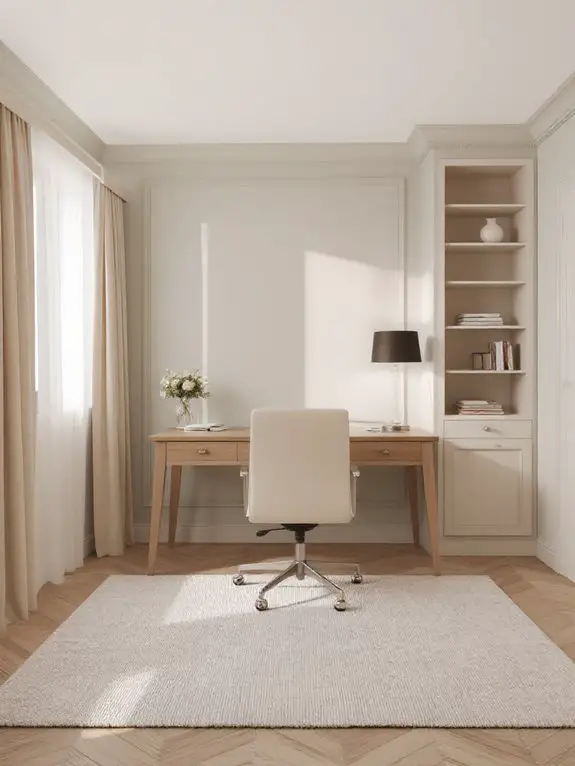
When designing a home office, choosing the right color palette can substantially influence both productivity and mood. I prefer soft, neutral tones like beige, light gray, or muted blues and greens, as they create a serene atmosphere that helps me focus. Warmer shades like pale yellow or creamy white can add warmth without overwhelming the space.
Avoid overly bright or intense colors, as they can be distracting or induce stress. I also consider natural light; lighter shades reflect it well, making the room feel airy and open. A calming palette sets the tone for a workspace that feels both inviting and efficient.
Personalize With Art and Decor
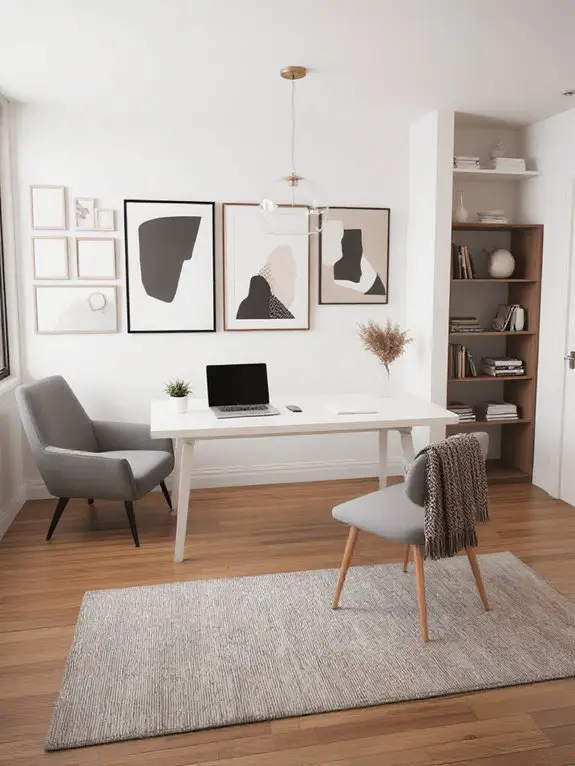
To make my home office feel uniquely mine, I carefully select art and decor that reflects my personality and inspires creativity. I choose pieces that evoke emotion or spark motivation, like framed quotes, vibrant paintings, or minimalist prints.
Personal mementos, such as travel souvenirs or family photos, add warmth and connection. I also incorporate functional decor, like stylish organizers or a textured area rug, to blend aesthetics with practicality.
Arranging these items thoughtfully creates a cohesive, inviting space. By curating art and decor that resonate with me, I’ve transformed my workspace into a reflection of who I am.
Invest in Quality Lighting
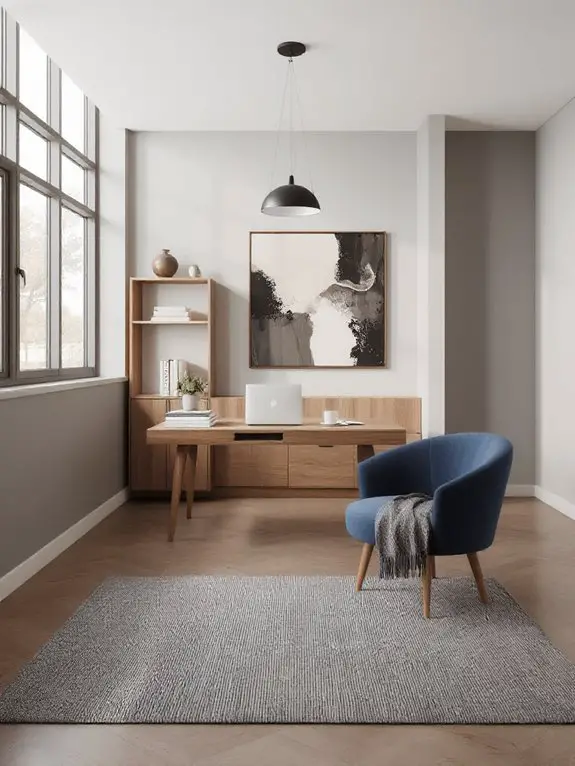
Good lighting is essential for creating a productive and comfortable home office environment. I’ve found that a combination of natural and artificial light works best to reduce eye strain and boost focus.
I always position my desk near a window to take advantage of daylight, but I also rely on layered lighting—a desk lamp for task lighting and overhead fixtures for ambient brightness.
I prefer LED bulbs with adjustable color temperatures, so I can shift between cool tones for concentration and warmer tones for relaxation. Dimmable options let me control brightness throughout the day, ensuring my workspace feels just right.
Create a Standing Desk Area
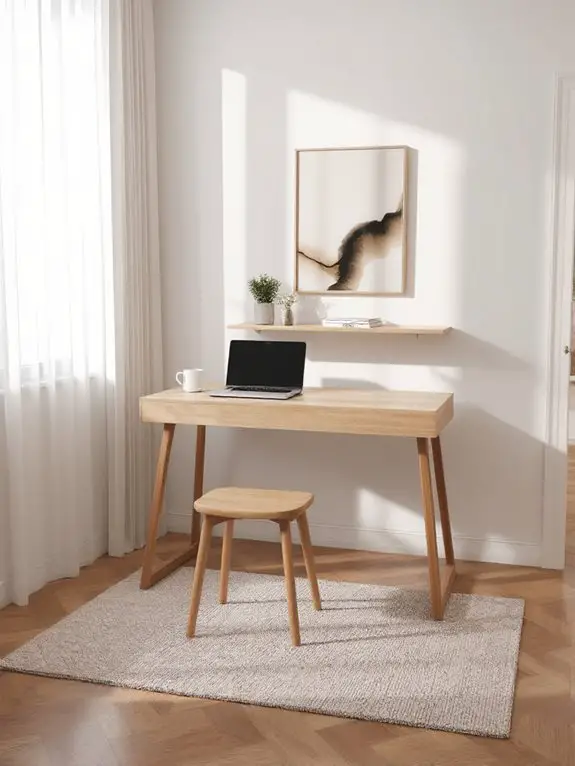
While I’ve found that sitting for long periods can drain my energy, incorporating a standing desk area has been a game-changer for my productivity and posture. I started by choosing an adjustable desk that allows me to easily switch between sitting and standing, ensuring flexibility throughout the day.
Positioning it near a window provides natural light and an invigorating view, which keeps me motivated. I also added an anti-fatigue mat to reduce strain on my legs and feet during extended standing sessions.
Setting a timer to alternate between positions every hour helps me maintain focus and avoid overexertion. This setup has made my workdays more dynamic and comfortable.
Organize With Desk Accessories
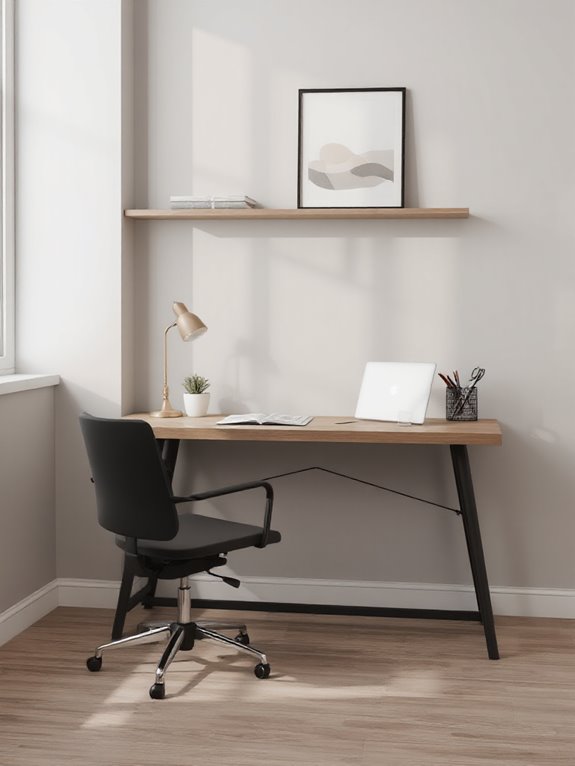
A well-organized desk can markedly enhance productivity and reduce unnecessary stress during work hours. I recommend starting with a sturdy desk organizer or tray to separate essential items like pens, sticky notes, and paper clips.
Use cable management clips or sleeves to keep cords tidy and prevent tangling. A small drawer divider can help sort office supplies, ensuring everything has its place.
I find it helpful to keep frequently used items, like my notebook or planner, within arm’s reach. A dedicated spot for my phone and coffee mug keeps distractions minimal.
Investing in stylish but functional accessories can also elevate the workspace’s aesthetic while maintaining order.
Design a Cozy Reading Nook
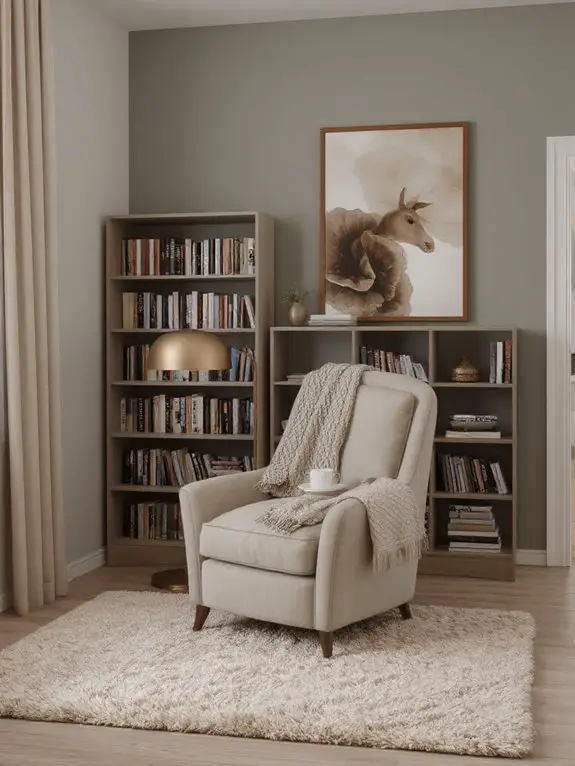
Creating a cozy reading nook begins with selecting the right location—a quiet corner with natural light works best, but if that’s not possible, I’ll add a warm, adjustable lamp to mimic daylight.
I choose a comfortable chair or chaise lounge, ensuring it supports good posture with cushions or a throw blanket for extra warmth.
Nearby, I place a small side table to hold my book, a cup of tea, or reading glasses.
Adding a soft rug underneath grounds the space, while bookshelves or a stack of favorites within arm’s reach make it functional.
Plants or artwork add personality, making it inviting.
Integrate Technology Seamlessly
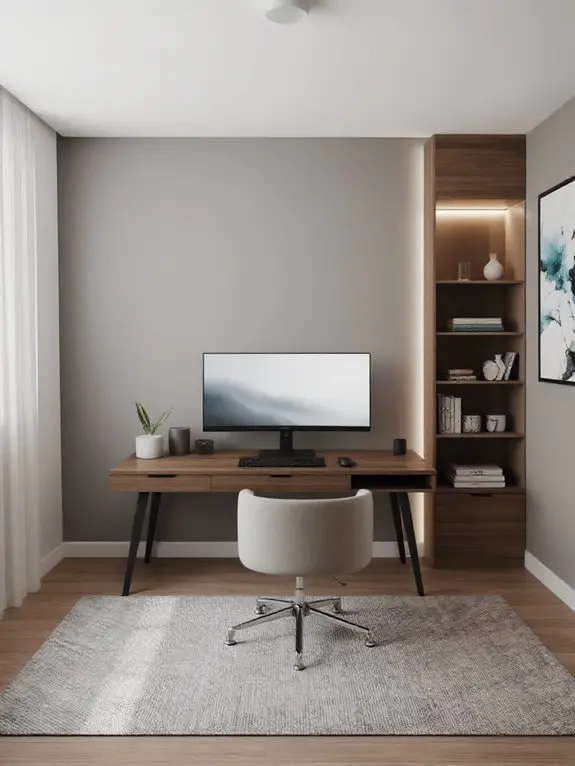
To integrate technology seamlessly into my home office, I start by considering the essentials—like a reliable laptop or desktop, a high-quality monitor, and ergonomic peripherals. I make sure cables are neatly organized using cable ties or raceways to avoid clutter.
Smart plugs and surge protectors keep devices powered efficiently. For audio, I opt for wireless speakers or noise-canceling headphones to minimize distractions.
I also invest in cloud storage to keep files secure and accessible. A docking station simplifies connecting multiple devices, while a wireless printer eliminates unnecessary wires.
Finally, I prioritize software tools like task managers and collaboration platforms to enhance productivity.
Maximize Small Spaces
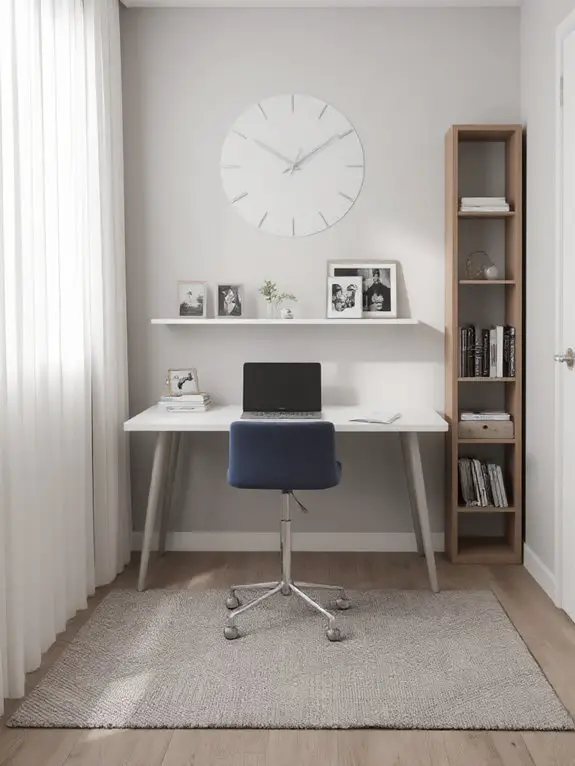
When working with limited square footage, I start by carefully evaluating how I can optimize every inch of my home office. I choose a compact desk that fits snugly against a wall or in a corner, saving floor space while still providing a functional workspace.
Modular furniture, like stackable storage units or foldable chairs, allows me to adapt the area as needed. I use vertical space efficiently by mounting shelves or a pegboard for supplies.
A minimalist approach guarantees only essentials are on display, reducing clutter. Lighting is vital—I opt for wall-mounted or desk lamps to free up surface areas.
Use Open Shelving for Display
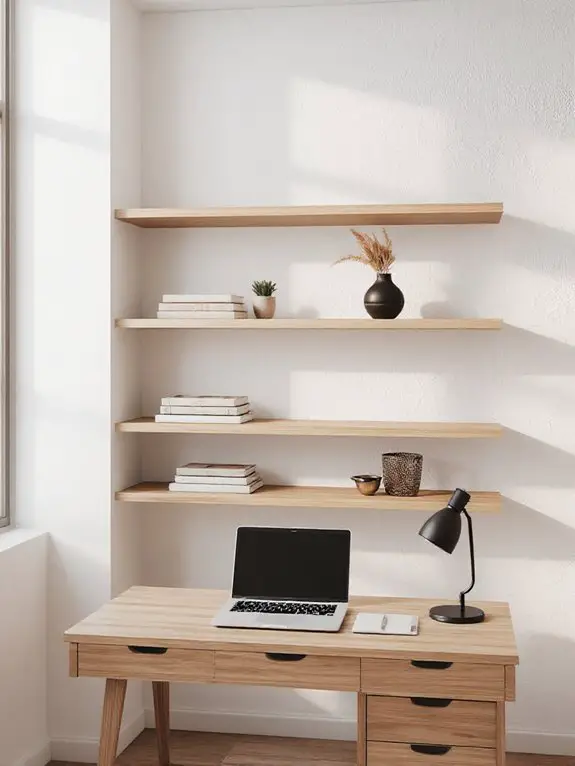
Since open shelving can both enhance functionality and add visual appeal, I’ve found it to be an excellent solution for organizing and displaying items in my home office. I use it to showcase books, plants, and decorative pieces that inspire creativity while keeping essentials within reach. To avoid clutter, I limit the number of items per shelf and group them by theme or color.
Floating shelves are my go-to for a modern, minimalist look, but ladder shelves work beautifully for a rustic vibe. Regularly rotating items keeps the display fresh and guarantees it reflects my evolving style and needs.
Add a Whiteboard or Corkboard

Adding a whiteboard or corkboard to my home office has been a game-changer for staying organized and sparking creativity. I use the whiteboard to jot down quick notes, brainstorm ideas, and map out projects. It’s perfect for visualizing my workflow and keeps everything top of mind.
The corkboard, on the other hand, holds reminders, inspirational quotes, and important documents. I love how both tools keep clutter off my desk while still being accessible. Mounting them on the wall saves space and creates a functional focal point. Whether you’re planning tasks or displaying creativity, these additions make a huge difference in productivity.
Incorporate Soundproofing Elements
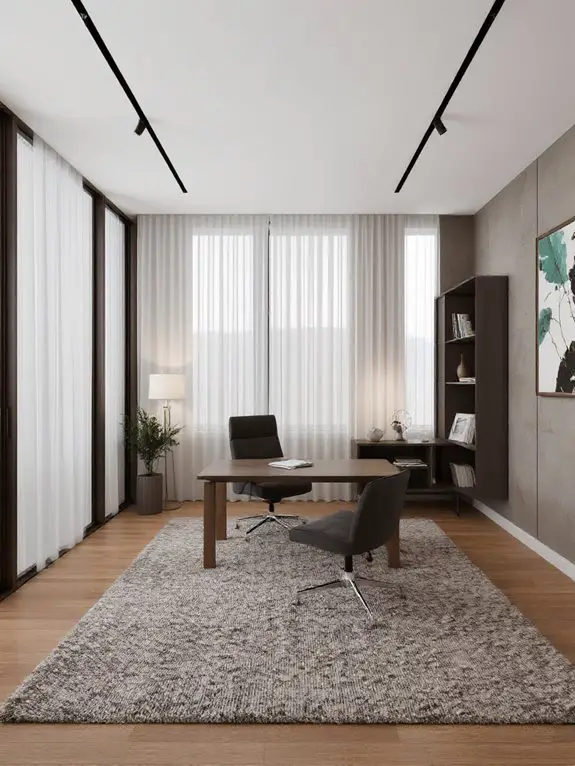
Soundproofing my home office has made a noticeable difference in reducing distractions and creating a quieter workspace. I started by sealing gaps around doors and windows with weatherstripping or acoustic caulk to block outside noise.
Next, I added thick, noise-absorbing curtains and a plush area rug to dampen echoes and footsteps. Installing acoustic foam panels on the walls helped reduce sound reflections, making the room feel more peaceful.
I also placed furniture strategically, like bookshelves filled with books, to act as sound barriers. These small changes transformed my office into a serene environment where I can focus without interruptions.
Choose a Statement Desk
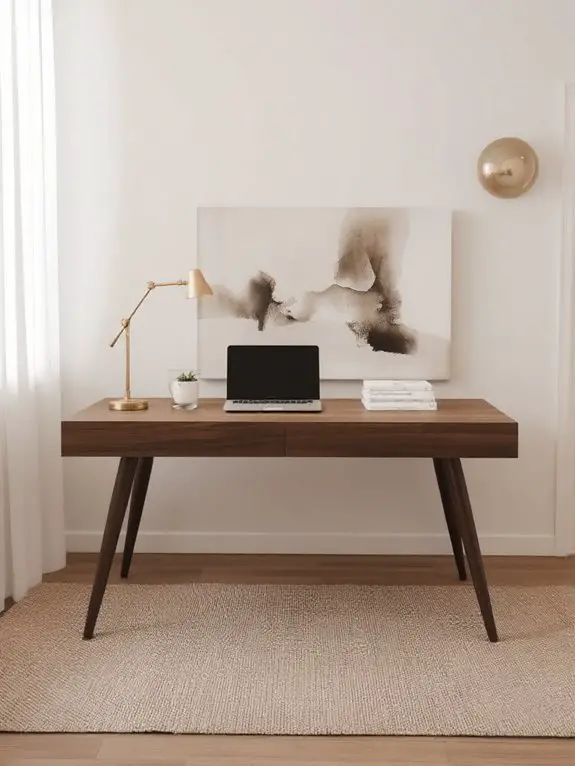
Your desk is the centerpiece of your home office—it’s where ideas come to life and productivity takes shape. I always recommend choosing a desk that reflects your style while meeting your functional needs.
Opt for materials like solid wood for durability or glass for a modern touch. Consider the size; it should fit your space without overwhelming it.
Look for features like built-in storage or cable management to keep things tidy.
A statement desk isn’t just practical—it’s a focal point that sets the tone for your workspace. Invest in one that inspires you to sit down and get to work.
Design a Dual-Purpose Room
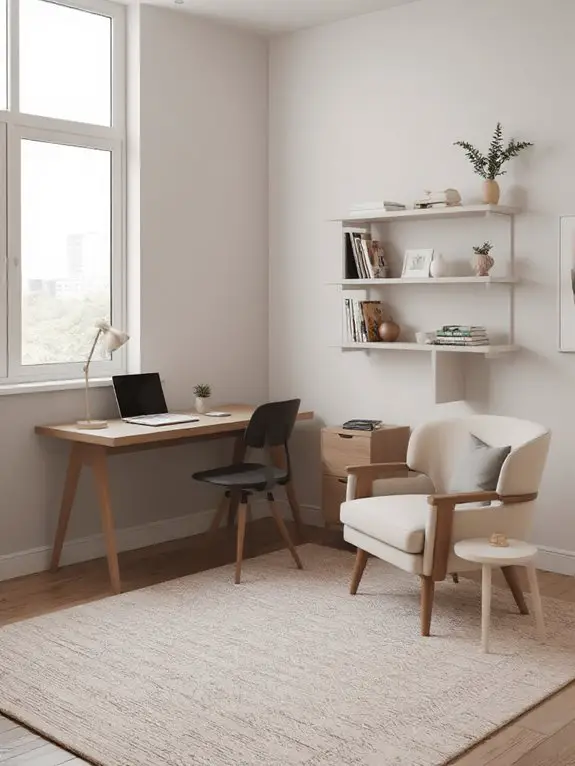
Designing a dual-purpose room requires thoughtful planning to balance functionality without compromising style. I start by identifying the primary uses—like a home office that doubles as a guest room.
I choose versatile furniture, such as a sleek Murphy bed or a foldable desk, to maximize space. Storage is key, so I opt for multi-functional pieces like ottomans with hidden compartments.
Lighting plays a big role; I layer task and ambient lights to suit both activities. I keep the decor minimal but impactful, using a cohesive color palette to unify the space.
This approach guarantees the room feels organized and purposeful.
Use Rugs to Define the Space
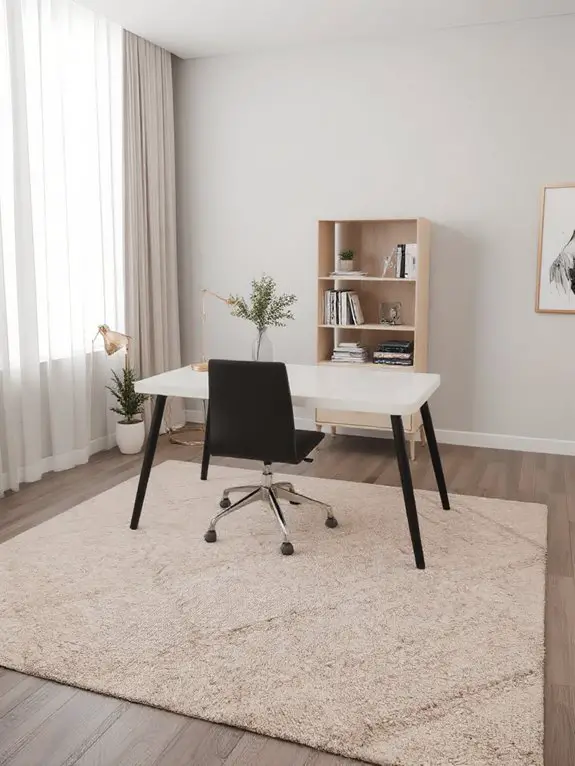
When I’m aiming to create distinct zones in a home office, rugs become one of my go-to tools for defining space. A well-placed rug can visually separate your work area from adjacent seating or storage, even in an open-plan room.
I prefer rugs with simple patterns or neutral tones to avoid overwhelming the space, but bold colors can add personality if the room needs a focal point. Size is critical—it should fit under your desk and chair but leave room for clear pathways.
For cohesion, I coordinate the rug’s texture or palette with other elements like furniture or decor.
Incorporate Hidden Storage Solutions
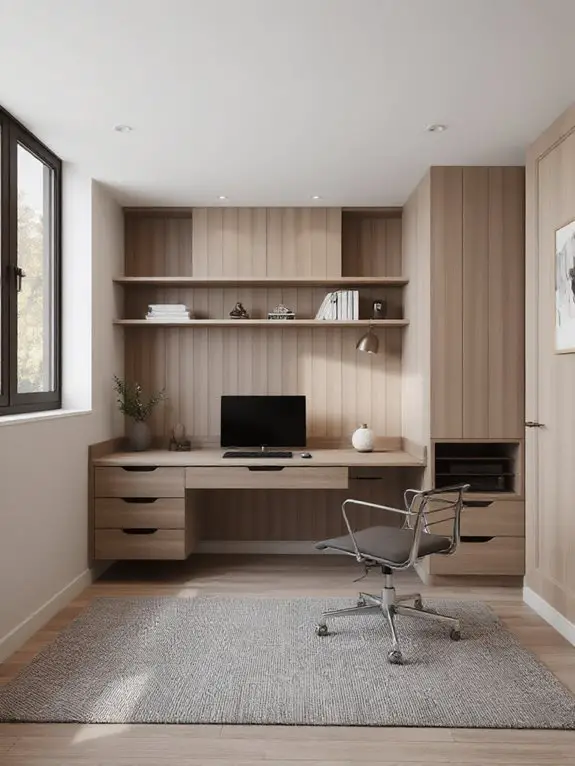
Hidden storage solutions are a game-changer for maintaining a clutter-free and organized home office. I’ve found that maximizing vertical space with built-in cabinets or shelves keeps essentials within reach yet out of sight.
Drawers under desks or benches are perfect for stashing paperwork or tech accessories. Magnetic strips or pegboards can hide tools like scissors or chargers while remaining functional.
Floating shelves with concealed compartments blend seamlessly into the decor. Even furniture like ottomans or benches with hidden storage can double as seating while keeping clutter at bay.
These clever solutions save space and create a polished, professional environment without sacrificing functionality.
Opt for Adjustable Furniture
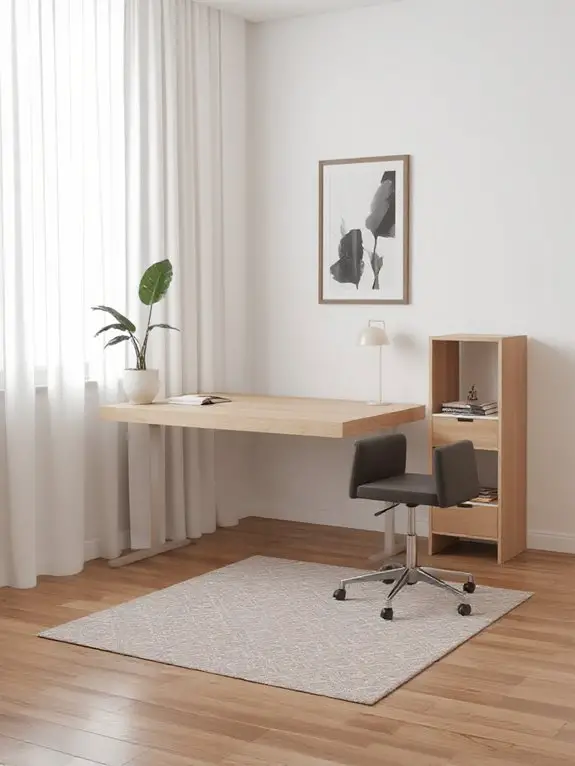
Opting for adjustable furniture can transform your home office, guaranteeing it adapts to your needs rather than forcing you to conform to it. I prioritize desks and chairs with adjustable heights to reduce strain and improve posture during long work sessions.
A sit-stand desk, for instance, allows me to switch positions throughout the day, boosting energy and focus. Ergonomic chairs with lumbar support and customizable armrests make a noticeable difference in comfort.
I also love modular shelving or monitor stands that can be repositioned as my workflow changes. Investing in adaptability assures my workspace evolves with me, enhancing productivity and well-being.
Add Inspirational Quotes or Vision Boards
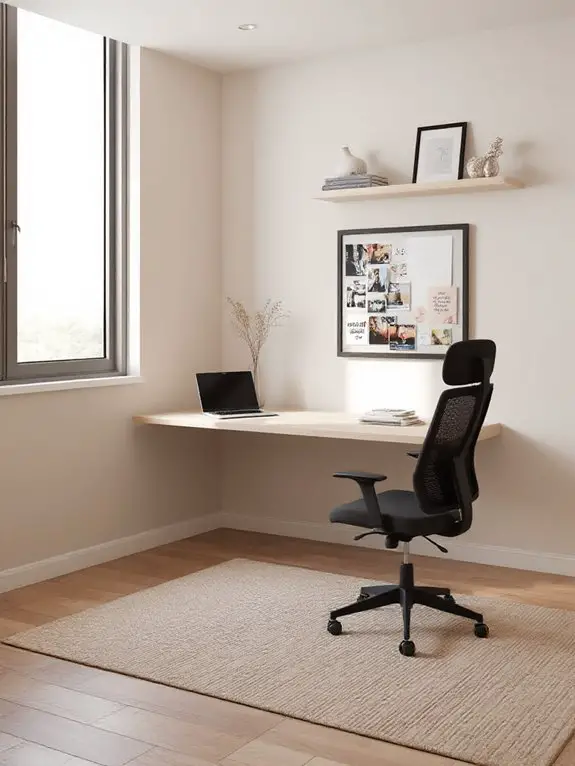
Why not surround yourself with daily reminders of your goals and aspirations? I’ve found that adding inspirational quotes or a vision board to my home office keeps me motivated and focused.
I pin quotes that resonate with me—ones that remind me of what I’m working toward. For my vision board, I include images, phrases, and symbols that represent my dreams, whether it’s a promotion, a creative project, or personal growth.
It’s not just decorative; it’s a powerful tool to keep my mindset positive and aligned with my ambitions. These small additions make my workspace feel purposeful and inspiring.
Keep Cables and Wires Tidy

While my vision board keeps me inspired, I’ve learned that a cluttered desk with tangled cables can quickly disrupt that focus. To manage cords effectively, I use cable ties or clips to bundle them neatly along the desk’s edge.
A desk grommet or tray hides excess wires, maintaining a clean surface. Labeling each cable helps me identify them quickly, saving time during setup. Wireless devices, like keyboards and mice, also minimize clutter.
For chargers, I designate a docking station to keep devices organized. A tidy workspace not only looks professional but also boosts productivity and peace of mind.
Frequently Asked Questions
How Do I Choose the Right Desk Size?
I’d start by measuring the space where I plan to put my desk, ensuring there’s enough room for movement. Next, I’d consider what I’ll use it for—work, hobbies, or both—and pick a size that fits my needs.
What’S the Best Way to Reduce Glare on Screens?
I’ve found reducing screen glare starts with positioning my monitor perpendicular to windows. I also use an anti-glare screen protector and adjust my lighting to avoid direct beams hitting the screen. It’s made a huge difference.
How Can I Create a Budget-Friendly Home Office?
I start by decluttering and repurposing furniture I already own. I look for second-hand desks or shelves at thrift stores. I use affordable organizers and DIY decor to keep costs low while maintaining functionality and style.
What Plants Are Best for Low-Light Offices?
I need plants that thrive in dim light, resist neglect, and enhance my space. Peace lilies purify air, snake plants survive with little care, and pothos vines grow effortlessly—all perfect for my low-light office.
How Often Should I Clean My Home Office?
I’d clean my home office at least once a week to keep it tidy—wipe down surfaces, vacuum, and dust. High-touch areas like my keyboard and desk get a quick clean daily to stay germ-free.

